Individual Report: Analyzing Organizational Communication Practices
VerifiedAdded on 2021/02/19
|7
|1865
|22
Report
AI Summary
This individual report, titled "SECOND ASSESSMENT INDIVIDUAL REPORT MR FISHY," delves into the multifaceted realm of organizational communication. It begins by exploring the diverse forms of communication, including formal, informal, directional, internal, external, oral, and written communication, and elucidates their respective purposes within an organization. The report then transitions to the principles of effective communication, presenting the 7 C's: completeness, concreteness, courtesy, correctness, clarity, consideration, and conciseness. The analysis section applies these concepts to a specific organizational context, Mr. Fishy, suggesting strategies to mitigate cultural differences and enhance communication efficiency. The report recommends the use of formal, horizontal, and oral communication methods to improve trust and clarity within the organization. The report concludes by emphasizing the importance of implementing the identified communication practices to improve overall performance. The report references several academic sources to support its claims.
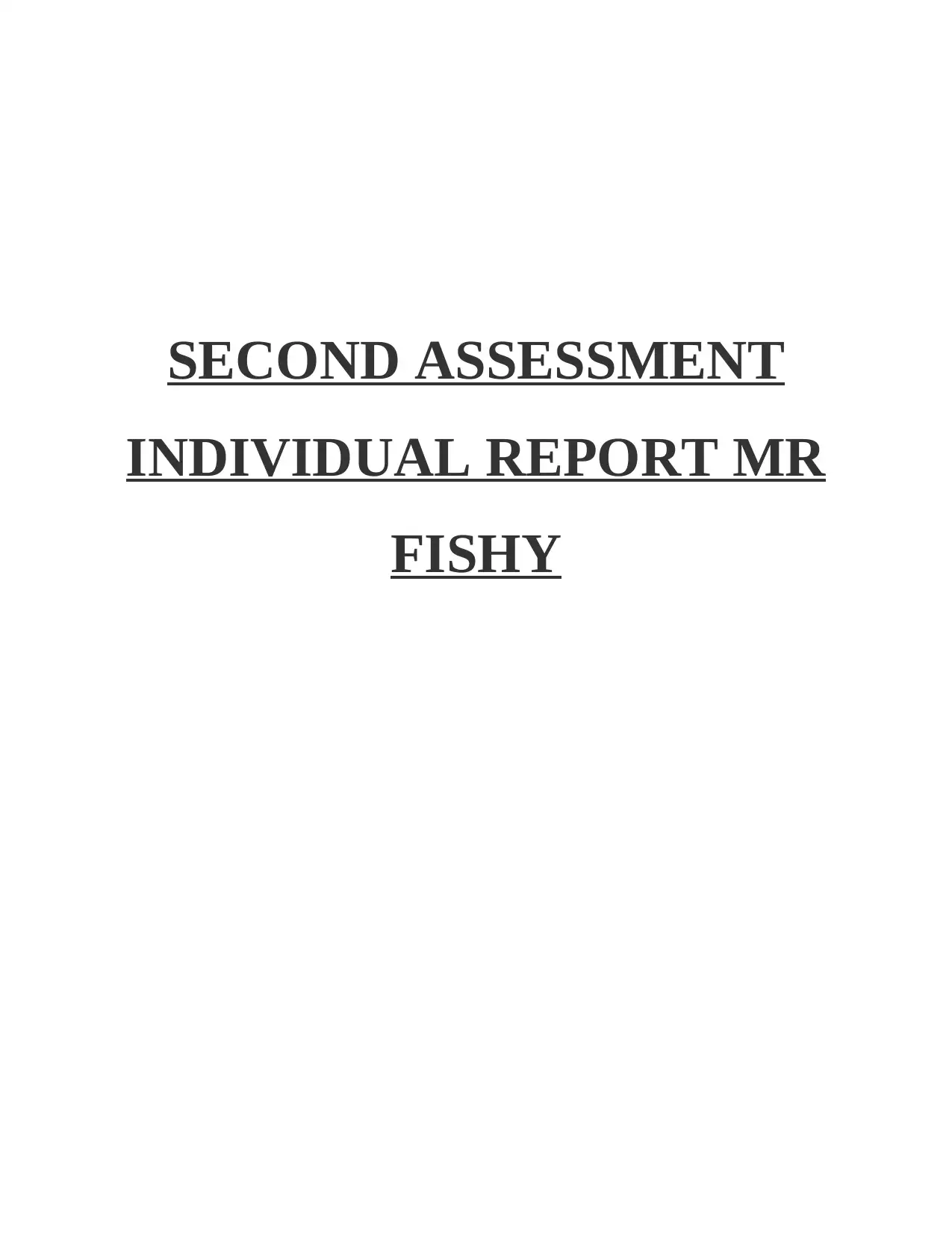
SECOND ASSESSMENT
INDIVIDUAL REPORT MR
FISHY
INDIVIDUAL REPORT MR
FISHY
Paraphrase This Document
Need a fresh take? Get an instant paraphrase of this document with our AI Paraphraser
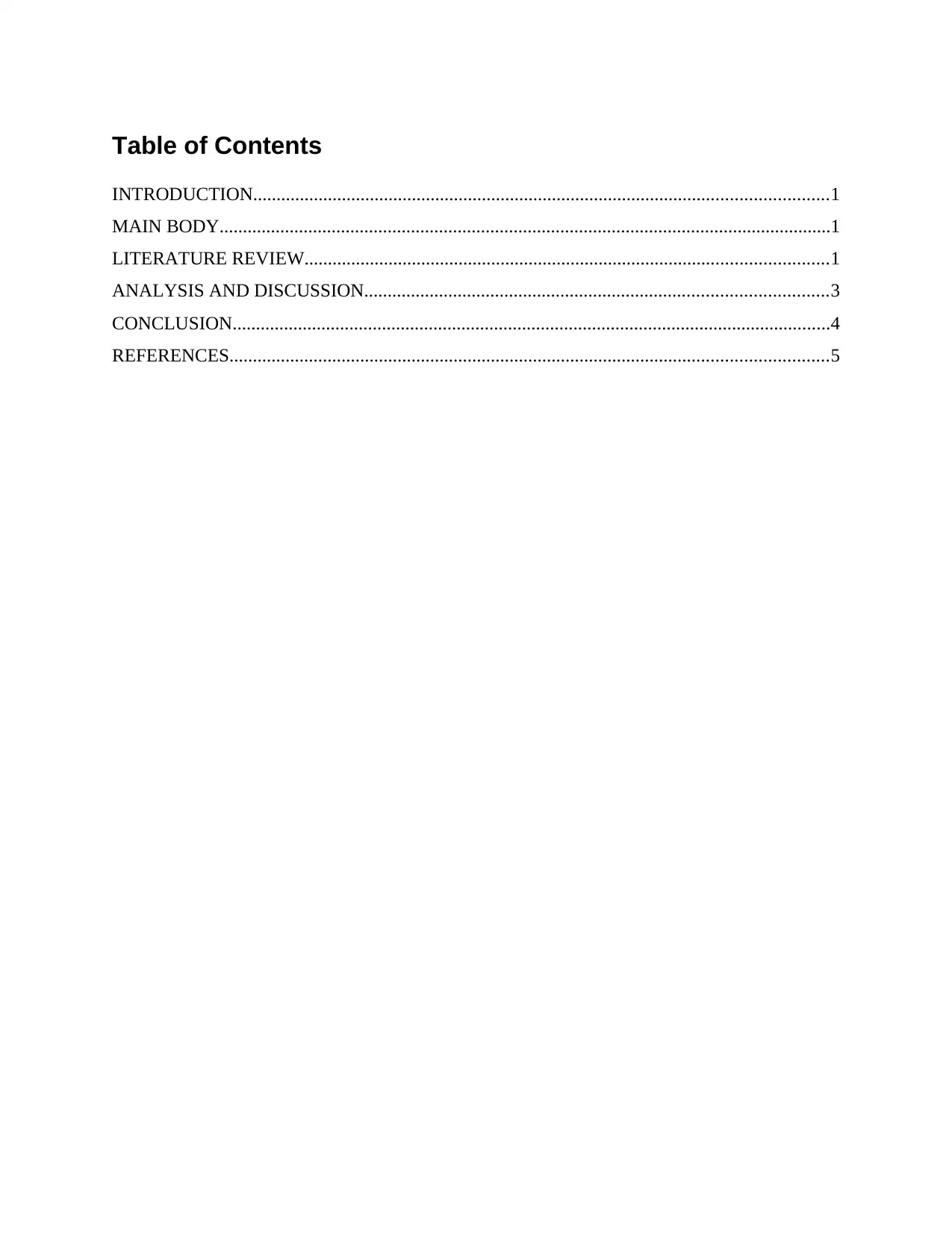
Table of Contents
INTRODUCTION...........................................................................................................................1
MAIN BODY...................................................................................................................................1
LITERATURE REVIEW................................................................................................................1
ANALYSIS AND DISCUSSION...................................................................................................3
CONCLUSION................................................................................................................................4
REFERENCES................................................................................................................................5
INTRODUCTION...........................................................................................................................1
MAIN BODY...................................................................................................................................1
LITERATURE REVIEW................................................................................................................1
ANALYSIS AND DISCUSSION...................................................................................................3
CONCLUSION................................................................................................................................4
REFERENCES................................................................................................................................5
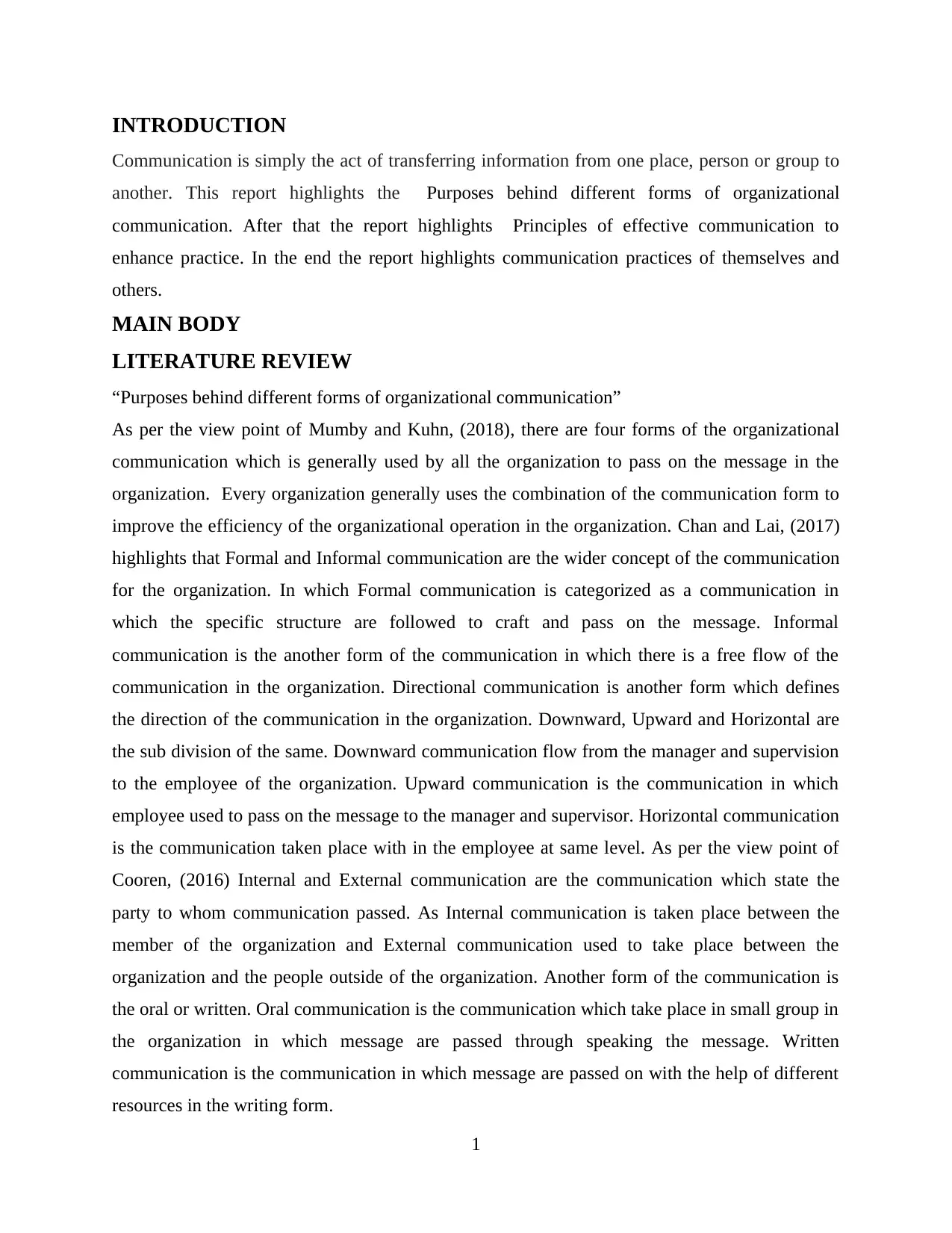
INTRODUCTION
Communication is simply the act of transferring information from one place, person or group to
another. This report highlights the Purposes behind different forms of organizational
communication. After that the report highlights Principles of effective communication to
enhance practice. In the end the report highlights communication practices of themselves and
others.
MAIN BODY
LITERATURE REVIEW
“Purposes behind different forms of organizational communication”
As per the view point of Mumby and Kuhn, (2018), there are four forms of the organizational
communication which is generally used by all the organization to pass on the message in the
organization. Every organization generally uses the combination of the communication form to
improve the efficiency of the organizational operation in the organization. Chan and Lai, (2017)
highlights that Formal and Informal communication are the wider concept of the communication
for the organization. In which Formal communication is categorized as a communication in
which the specific structure are followed to craft and pass on the message. Informal
communication is the another form of the communication in which there is a free flow of the
communication in the organization. Directional communication is another form which defines
the direction of the communication in the organization. Downward, Upward and Horizontal are
the sub division of the same. Downward communication flow from the manager and supervision
to the employee of the organization. Upward communication is the communication in which
employee used to pass on the message to the manager and supervisor. Horizontal communication
is the communication taken place with in the employee at same level. As per the view point of
Cooren, (2016) Internal and External communication are the communication which state the
party to whom communication passed. As Internal communication is taken place between the
member of the organization and External communication used to take place between the
organization and the people outside of the organization. Another form of the communication is
the oral or written. Oral communication is the communication which take place in small group in
the organization in which message are passed through speaking the message. Written
communication is the communication in which message are passed on with the help of different
resources in the writing form.
1
Communication is simply the act of transferring information from one place, person or group to
another. This report highlights the Purposes behind different forms of organizational
communication. After that the report highlights Principles of effective communication to
enhance practice. In the end the report highlights communication practices of themselves and
others.
MAIN BODY
LITERATURE REVIEW
“Purposes behind different forms of organizational communication”
As per the view point of Mumby and Kuhn, (2018), there are four forms of the organizational
communication which is generally used by all the organization to pass on the message in the
organization. Every organization generally uses the combination of the communication form to
improve the efficiency of the organizational operation in the organization. Chan and Lai, (2017)
highlights that Formal and Informal communication are the wider concept of the communication
for the organization. In which Formal communication is categorized as a communication in
which the specific structure are followed to craft and pass on the message. Informal
communication is the another form of the communication in which there is a free flow of the
communication in the organization. Directional communication is another form which defines
the direction of the communication in the organization. Downward, Upward and Horizontal are
the sub division of the same. Downward communication flow from the manager and supervision
to the employee of the organization. Upward communication is the communication in which
employee used to pass on the message to the manager and supervisor. Horizontal communication
is the communication taken place with in the employee at same level. As per the view point of
Cooren, (2016) Internal and External communication are the communication which state the
party to whom communication passed. As Internal communication is taken place between the
member of the organization and External communication used to take place between the
organization and the people outside of the organization. Another form of the communication is
the oral or written. Oral communication is the communication which take place in small group in
the organization in which message are passed through speaking the message. Written
communication is the communication in which message are passed on with the help of different
resources in the writing form.
1
⊘ This is a preview!⊘
Do you want full access?
Subscribe today to unlock all pages.

Trusted by 1+ million students worldwide
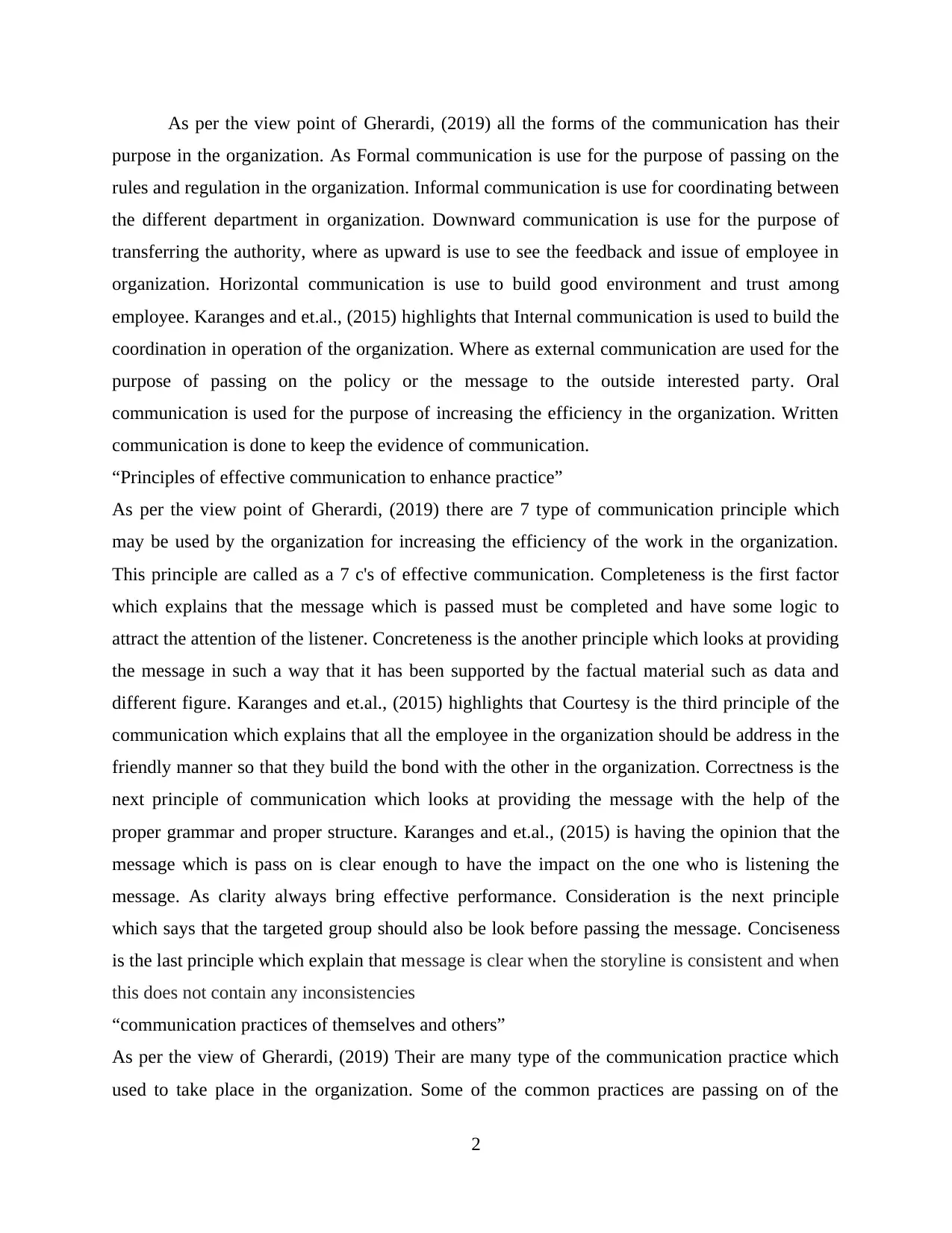
As per the view point of Gherardi, (2019) all the forms of the communication has their
purpose in the organization. As Formal communication is use for the purpose of passing on the
rules and regulation in the organization. Informal communication is use for coordinating between
the different department in organization. Downward communication is use for the purpose of
transferring the authority, where as upward is use to see the feedback and issue of employee in
organization. Horizontal communication is use to build good environment and trust among
employee. Karanges and et.al., (2015) highlights that Internal communication is used to build the
coordination in operation of the organization. Where as external communication are used for the
purpose of passing on the policy or the message to the outside interested party. Oral
communication is used for the purpose of increasing the efficiency in the organization. Written
communication is done to keep the evidence of communication.
“Principles of effective communication to enhance practice”
As per the view point of Gherardi, (2019) there are 7 type of communication principle which
may be used by the organization for increasing the efficiency of the work in the organization.
This principle are called as a 7 c's of effective communication. Completeness is the first factor
which explains that the message which is passed must be completed and have some logic to
attract the attention of the listener. Concreteness is the another principle which looks at providing
the message in such a way that it has been supported by the factual material such as data and
different figure. Karanges and et.al., (2015) highlights that Courtesy is the third principle of the
communication which explains that all the employee in the organization should be address in the
friendly manner so that they build the bond with the other in the organization. Correctness is the
next principle of communication which looks at providing the message with the help of the
proper grammar and proper structure. Karanges and et.al., (2015) is having the opinion that the
message which is pass on is clear enough to have the impact on the one who is listening the
message. As clarity always bring effective performance. Consideration is the next principle
which says that the targeted group should also be look before passing the message. Conciseness
is the last principle which explain that message is clear when the storyline is consistent and when
this does not contain any inconsistencies
“communication practices of themselves and others”
As per the view of Gherardi, (2019) Their are many type of the communication practice which
used to take place in the organization. Some of the common practices are passing on of the
2
purpose in the organization. As Formal communication is use for the purpose of passing on the
rules and regulation in the organization. Informal communication is use for coordinating between
the different department in organization. Downward communication is use for the purpose of
transferring the authority, where as upward is use to see the feedback and issue of employee in
organization. Horizontal communication is use to build good environment and trust among
employee. Karanges and et.al., (2015) highlights that Internal communication is used to build the
coordination in operation of the organization. Where as external communication are used for the
purpose of passing on the policy or the message to the outside interested party. Oral
communication is used for the purpose of increasing the efficiency in the organization. Written
communication is done to keep the evidence of communication.
“Principles of effective communication to enhance practice”
As per the view point of Gherardi, (2019) there are 7 type of communication principle which
may be used by the organization for increasing the efficiency of the work in the organization.
This principle are called as a 7 c's of effective communication. Completeness is the first factor
which explains that the message which is passed must be completed and have some logic to
attract the attention of the listener. Concreteness is the another principle which looks at providing
the message in such a way that it has been supported by the factual material such as data and
different figure. Karanges and et.al., (2015) highlights that Courtesy is the third principle of the
communication which explains that all the employee in the organization should be address in the
friendly manner so that they build the bond with the other in the organization. Correctness is the
next principle of communication which looks at providing the message with the help of the
proper grammar and proper structure. Karanges and et.al., (2015) is having the opinion that the
message which is pass on is clear enough to have the impact on the one who is listening the
message. As clarity always bring effective performance. Consideration is the next principle
which says that the targeted group should also be look before passing the message. Conciseness
is the last principle which explain that message is clear when the storyline is consistent and when
this does not contain any inconsistencies
“communication practices of themselves and others”
As per the view of Gherardi, (2019) Their are many type of the communication practice which
used to take place in the organization. Some of the common practices are passing on of the
2
Paraphrase This Document
Need a fresh take? Get an instant paraphrase of this document with our AI Paraphraser
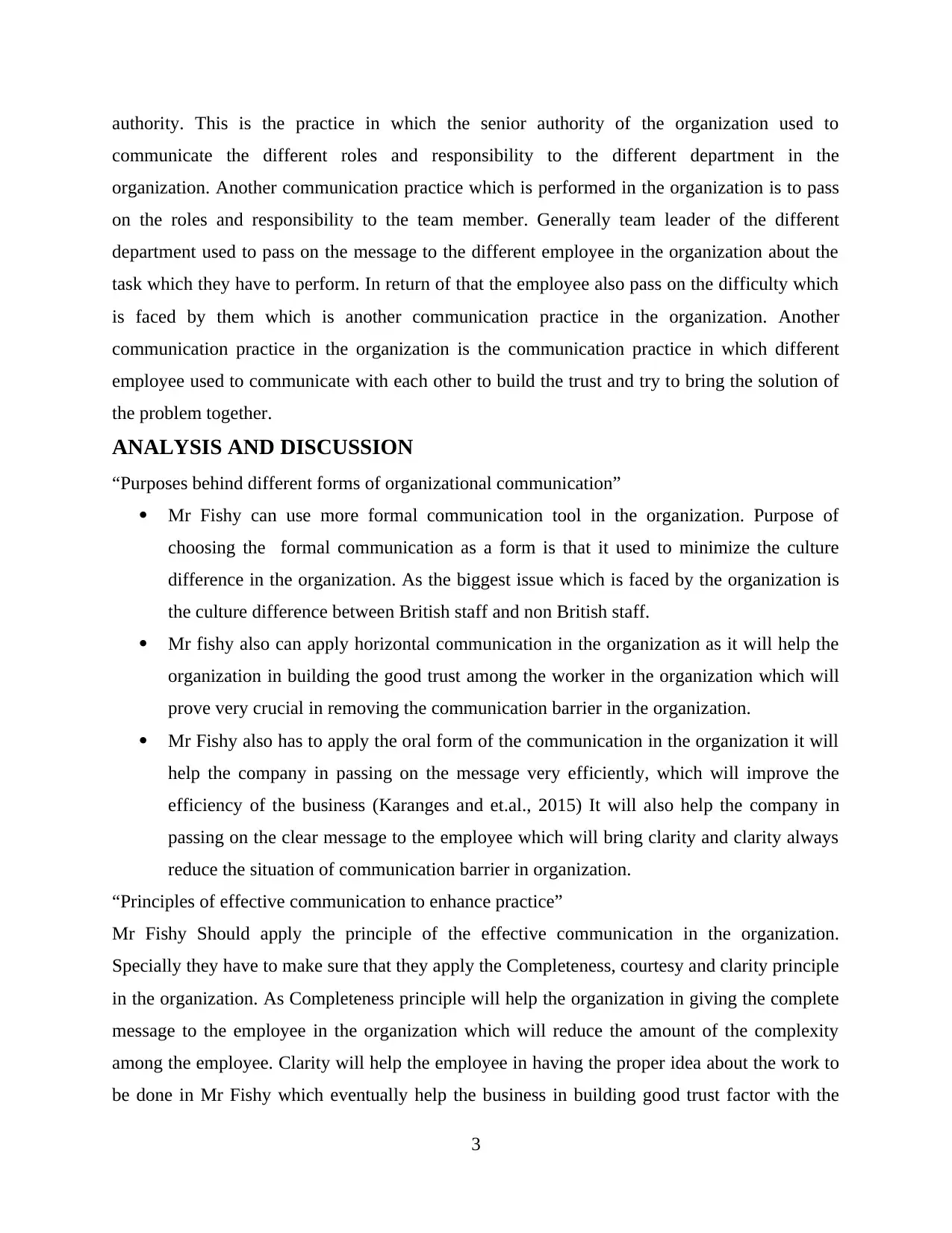
authority. This is the practice in which the senior authority of the organization used to
communicate the different roles and responsibility to the different department in the
organization. Another communication practice which is performed in the organization is to pass
on the roles and responsibility to the team member. Generally team leader of the different
department used to pass on the message to the different employee in the organization about the
task which they have to perform. In return of that the employee also pass on the difficulty which
is faced by them which is another communication practice in the organization. Another
communication practice in the organization is the communication practice in which different
employee used to communicate with each other to build the trust and try to bring the solution of
the problem together.
ANALYSIS AND DISCUSSION
“Purposes behind different forms of organizational communication”
Mr Fishy can use more formal communication tool in the organization. Purpose of
choosing the formal communication as a form is that it used to minimize the culture
difference in the organization. As the biggest issue which is faced by the organization is
the culture difference between British staff and non British staff.
Mr fishy also can apply horizontal communication in the organization as it will help the
organization in building the good trust among the worker in the organization which will
prove very crucial in removing the communication barrier in the organization.
Mr Fishy also has to apply the oral form of the communication in the organization it will
help the company in passing on the message very efficiently, which will improve the
efficiency of the business (Karanges and et.al., 2015) It will also help the company in
passing on the clear message to the employee which will bring clarity and clarity always
reduce the situation of communication barrier in organization.
“Principles of effective communication to enhance practice”
Mr Fishy Should apply the principle of the effective communication in the organization.
Specially they have to make sure that they apply the Completeness, courtesy and clarity principle
in the organization. As Completeness principle will help the organization in giving the complete
message to the employee in the organization which will reduce the amount of the complexity
among the employee. Clarity will help the employee in having the proper idea about the work to
be done in Mr Fishy which eventually help the business in building good trust factor with the
3
communicate the different roles and responsibility to the different department in the
organization. Another communication practice which is performed in the organization is to pass
on the roles and responsibility to the team member. Generally team leader of the different
department used to pass on the message to the different employee in the organization about the
task which they have to perform. In return of that the employee also pass on the difficulty which
is faced by them which is another communication practice in the organization. Another
communication practice in the organization is the communication practice in which different
employee used to communicate with each other to build the trust and try to bring the solution of
the problem together.
ANALYSIS AND DISCUSSION
“Purposes behind different forms of organizational communication”
Mr Fishy can use more formal communication tool in the organization. Purpose of
choosing the formal communication as a form is that it used to minimize the culture
difference in the organization. As the biggest issue which is faced by the organization is
the culture difference between British staff and non British staff.
Mr fishy also can apply horizontal communication in the organization as it will help the
organization in building the good trust among the worker in the organization which will
prove very crucial in removing the communication barrier in the organization.
Mr Fishy also has to apply the oral form of the communication in the organization it will
help the company in passing on the message very efficiently, which will improve the
efficiency of the business (Karanges and et.al., 2015) It will also help the company in
passing on the clear message to the employee which will bring clarity and clarity always
reduce the situation of communication barrier in organization.
“Principles of effective communication to enhance practice”
Mr Fishy Should apply the principle of the effective communication in the organization.
Specially they have to make sure that they apply the Completeness, courtesy and clarity principle
in the organization. As Completeness principle will help the organization in giving the complete
message to the employee in the organization which will reduce the amount of the complexity
among the employee. Clarity will help the employee in having the proper idea about the work to
be done in Mr Fishy which eventually help the business in building good trust factor with the
3
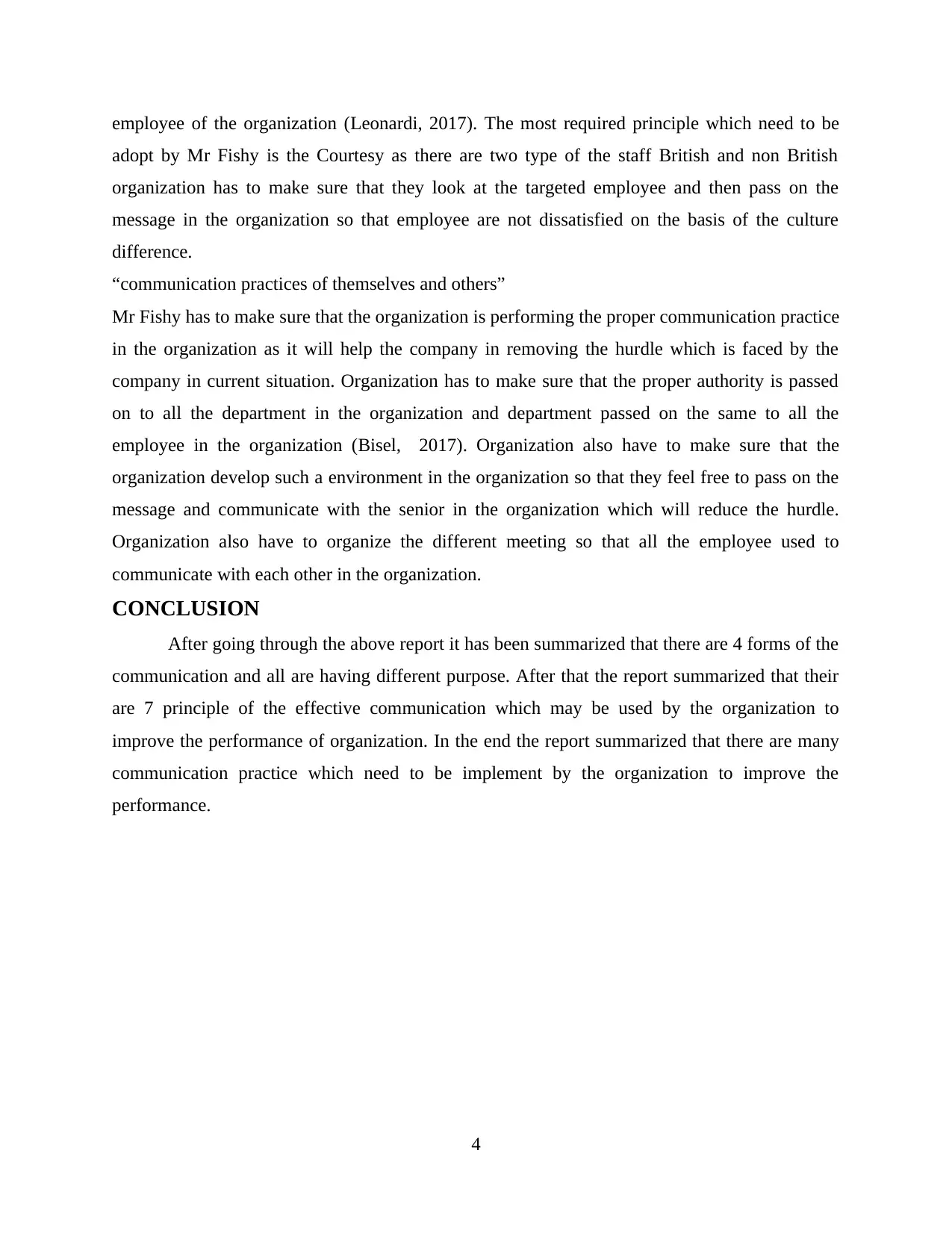
employee of the organization (Leonardi, 2017). The most required principle which need to be
adopt by Mr Fishy is the Courtesy as there are two type of the staff British and non British
organization has to make sure that they look at the targeted employee and then pass on the
message in the organization so that employee are not dissatisfied on the basis of the culture
difference.
“communication practices of themselves and others”
Mr Fishy has to make sure that the organization is performing the proper communication practice
in the organization as it will help the company in removing the hurdle which is faced by the
company in current situation. Organization has to make sure that the proper authority is passed
on to all the department in the organization and department passed on the same to all the
employee in the organization (Bisel, 2017). Organization also have to make sure that the
organization develop such a environment in the organization so that they feel free to pass on the
message and communicate with the senior in the organization which will reduce the hurdle.
Organization also have to organize the different meeting so that all the employee used to
communicate with each other in the organization.
CONCLUSION
After going through the above report it has been summarized that there are 4 forms of the
communication and all are having different purpose. After that the report summarized that their
are 7 principle of the effective communication which may be used by the organization to
improve the performance of organization. In the end the report summarized that there are many
communication practice which need to be implement by the organization to improve the
performance.
4
adopt by Mr Fishy is the Courtesy as there are two type of the staff British and non British
organization has to make sure that they look at the targeted employee and then pass on the
message in the organization so that employee are not dissatisfied on the basis of the culture
difference.
“communication practices of themselves and others”
Mr Fishy has to make sure that the organization is performing the proper communication practice
in the organization as it will help the company in removing the hurdle which is faced by the
company in current situation. Organization has to make sure that the proper authority is passed
on to all the department in the organization and department passed on the same to all the
employee in the organization (Bisel, 2017). Organization also have to make sure that the
organization develop such a environment in the organization so that they feel free to pass on the
message and communicate with the senior in the organization which will reduce the hurdle.
Organization also have to organize the different meeting so that all the employee used to
communicate with each other in the organization.
CONCLUSION
After going through the above report it has been summarized that there are 4 forms of the
communication and all are having different purpose. After that the report summarized that their
are 7 principle of the effective communication which may be used by the organization to
improve the performance of organization. In the end the report summarized that there are many
communication practice which need to be implement by the organization to improve the
performance.
4
⊘ This is a preview!⊘
Do you want full access?
Subscribe today to unlock all pages.

Trusted by 1+ million students worldwide
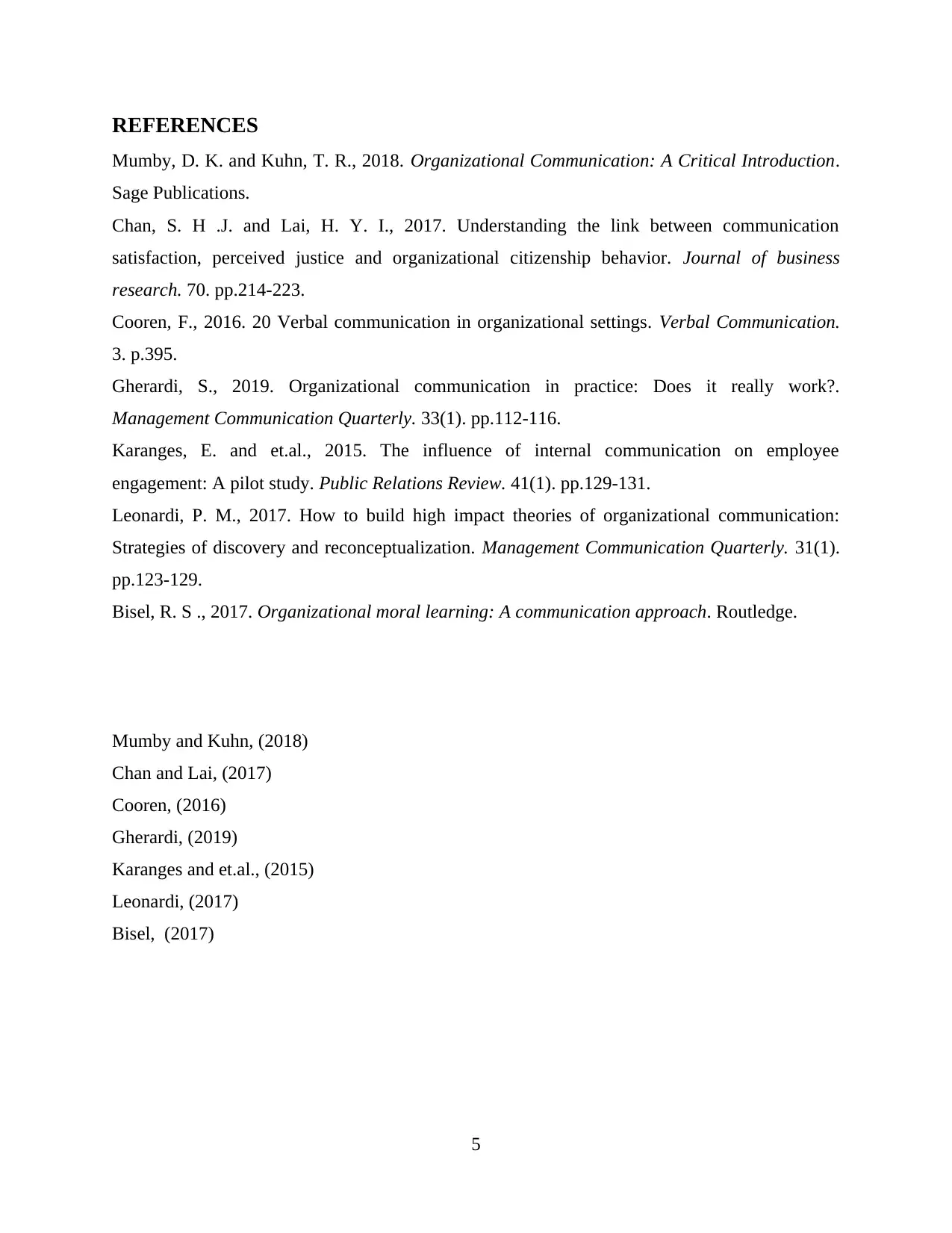
REFERENCES
Mumby, D. K. and Kuhn, T. R., 2018. Organizational Communication: A Critical Introduction.
Sage Publications.
Chan, S. H .J. and Lai, H. Y. I., 2017. Understanding the link between communication
satisfaction, perceived justice and organizational citizenship behavior. Journal of business
research. 70. pp.214-223.
Cooren, F., 2016. 20 Verbal communication in organizational settings. Verbal Communication.
3. p.395.
Gherardi, S., 2019. Organizational communication in practice: Does it really work?.
Management Communication Quarterly. 33(1). pp.112-116.
Karanges, E. and et.al., 2015. The influence of internal communication on employee
engagement: A pilot study. Public Relations Review. 41(1). pp.129-131.
Leonardi, P. M., 2017. How to build high impact theories of organizational communication:
Strategies of discovery and reconceptualization. Management Communication Quarterly. 31(1).
pp.123-129.
Bisel, R. S ., 2017. Organizational moral learning: A communication approach. Routledge.
Mumby and Kuhn, (2018)
Chan and Lai, (2017)
Cooren, (2016)
Gherardi, (2019)
Karanges and et.al., (2015)
Leonardi, (2017)
Bisel, (2017)
5
Mumby, D. K. and Kuhn, T. R., 2018. Organizational Communication: A Critical Introduction.
Sage Publications.
Chan, S. H .J. and Lai, H. Y. I., 2017. Understanding the link between communication
satisfaction, perceived justice and organizational citizenship behavior. Journal of business
research. 70. pp.214-223.
Cooren, F., 2016. 20 Verbal communication in organizational settings. Verbal Communication.
3. p.395.
Gherardi, S., 2019. Organizational communication in practice: Does it really work?.
Management Communication Quarterly. 33(1). pp.112-116.
Karanges, E. and et.al., 2015. The influence of internal communication on employee
engagement: A pilot study. Public Relations Review. 41(1). pp.129-131.
Leonardi, P. M., 2017. How to build high impact theories of organizational communication:
Strategies of discovery and reconceptualization. Management Communication Quarterly. 31(1).
pp.123-129.
Bisel, R. S ., 2017. Organizational moral learning: A communication approach. Routledge.
Mumby and Kuhn, (2018)
Chan and Lai, (2017)
Cooren, (2016)
Gherardi, (2019)
Karanges and et.al., (2015)
Leonardi, (2017)
Bisel, (2017)
5
1 out of 7
Related Documents
Your All-in-One AI-Powered Toolkit for Academic Success.
+13062052269
info@desklib.com
Available 24*7 on WhatsApp / Email
![[object Object]](/_next/static/media/star-bottom.7253800d.svg)
Unlock your academic potential
Copyright © 2020–2025 A2Z Services. All Rights Reserved. Developed and managed by ZUCOL.



